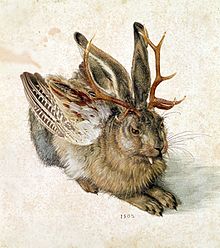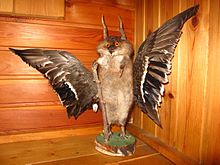Wolpertinger
The Wolpertinger is a Bavarian mythical creature whose exact origin is unclear. It is described and depicted as a hybrid creature in various forms, for example as a squirrel with a duck bill or a rabbit with duck wings.
Origin of name

The current name can vary slightly, depending on the area it is also called Wolperdinger , Woipertinger , Woiperdinger , Volpertinger , Walpertinger or Wulpertinger .
In parts of Lower Bavaria the mythical creature is referred to as Oibadrischl , in Upper Palatinate as Rammeschucksn , in Lower Austria and parts of Salzburg the term Raurackl is common in various spellings. The writer Ludwig Ganghofer referred to the creature as a red buck black foxgams . In their collection of German sagas , the Brothers Grimm report on a creature that was called Kreißl in 1753 , and the linguist Johann Andreas Schmeller also mentioned the proximity to today's screeching .
The origin of the name Wolpertinger is unclear. Bernd E. Ergert , Director of the German Hunting and Fishing Museum in Munich traces the name back to glassmakers from Wolterdingen near Donaueschingen. They made shot glasses in the shape of animal figures, commonly called Wolterdinger . Wolpertinger is said to have emerged from this through linguistic abrasion . The Große Brockhaus from 1994, vol. 24, provides another word explanation: According to this, Wolpertinger is related to the dialect of Walper , a distortion of Walpurgis Night .
Legend
reception
All that is known is that taxidermists began to assemble specimens from body parts of different animal species in the 19th century in order to sell them to gullible tourists.
The specimens of the prepared hides exhibited in the former Wolpertinger Museum in Mittenwald and in the German Hunting and Fishing Museum in Munich mostly show the Wolpertinger with a horned hare's head. Limbs from various animal species are usually attached to the body. The Wolpertinger often has wings instead of forelegs and the hind legs are designed with the feet of water birds. The composition was left to the taxidermist's imagination.
The writer Walter Moers gave the Wolpertinger a new look in his work Rumo & Die Wunder im Dunkeln : The Zamonisch Wolpertinger is a mixture of wolf and deer. Thus he has the aggressiveness and strength of a wolf, but is graceful and agile like a deer. The writer Alban Nikolai Herbst made Wolpertinger a symbolic figure in his novel Wolpertinger or Das Blau in 1993 . Here it stands for an art whole made up of heterogeneous parts and is at the same time an ironic expression of so-called postmodernism .
food
As a predator, the Wolpertinger should eat smaller animals, but also herbs and roots. According to information in the Munich Hunting and Fishing Museum, it feeds exclusively on Prussian soft skulls .
hunt
According to legend, the Wolpertinger is considered very shy. The different types of hunting for him differ greatly from region to region. A well-known hunting rule is: Wolpertinger can only be spotted by young, good-looking women if they entrust themselves to the company of a real, proper man who knows the right places on remote forest edges at dusk with a full moon.
Another rule is that the only way to catch it is to put salt on its tail. The method of setting off with a candle, sack, stick and spade when the moon is full is also common. The sack is held open by the stick and the candle is placed in front of the opening of the sack. If the Wolpertinger is attracted by the candlelight, you can drive him into the sack with the help of the spade. Another method has also been handed down: one illustration describes the Wolpertinger with legs of different lengths on the right and left, so that he can only walk in a fixed direction on free-standing hills. If it is possible to frighten it so that it turns around and wants to run back, it inevitably falls over and can be caught quickly (see also the hill chicken ).
Other mythical creatures
Folk mythical creatures with similar characteristics can also be found in other regions, whose mythological relationship to Wolpertinger is unclear:
- Blutschink (Tyrol)
- Bunyip (Australia)
- Dahu (Switzerland, France)
- Dilldapp (Alemannic and as Dilldapp in Siegerland)
- Elwetritsch (Palatinate)
- Gamusino (Spain)
- Hanghuhn (Thuringia)
- Jackalope (USA)
- Rattle rattle (Thuringia and Saxony)
- Skvader (Sweden)
- Raurakel (Austria)
See also
literature
- Alfons Schweiggert (author), Angelika Kaut (photos): And they do exist! The truth about the Wolpertinger . Verlag Ludwig, Pfaffenhofen / Ilm 1988, ISBN 3-7787-3325-7 .
- Alfons Schweiggert: The Wolpertinger or the horned hare. A serious investigation into a Bavarian phenomenon . Munich 1994
- Paul Schallweg: The Wolpertinger . ISBN 3-475-52795-2 .
- Reginald Huber: From the eagle to the Wolpertinger - the Bavarian bestiary . Bayerland VA, ISBN 3-89251-188-8 .
- Michael Heim: Living with the Wolpertinger . 1971, ISBN 3-87490-601-9 .
- Peter Kirein: Wolpertinger is alive . Lipp 1968, ISBN 3-87490-501-2 .
Web links
Otto Freimuth: The Wolpertinger from Bavaria
- Article "Im faunischen Bayern" , Bernd E. Ergert about the origin of the name of the Wolpertinger
- Inquiry: How did the fable figure of the Wolpertinger come about?


